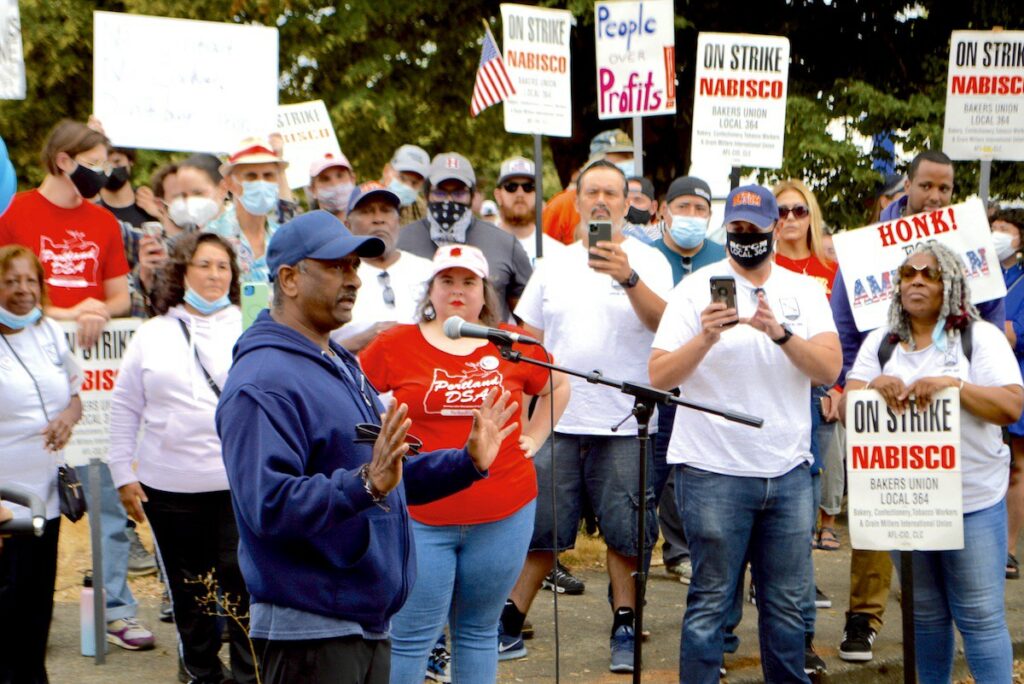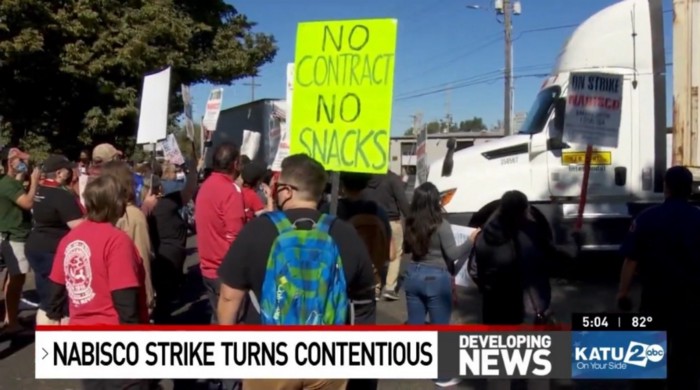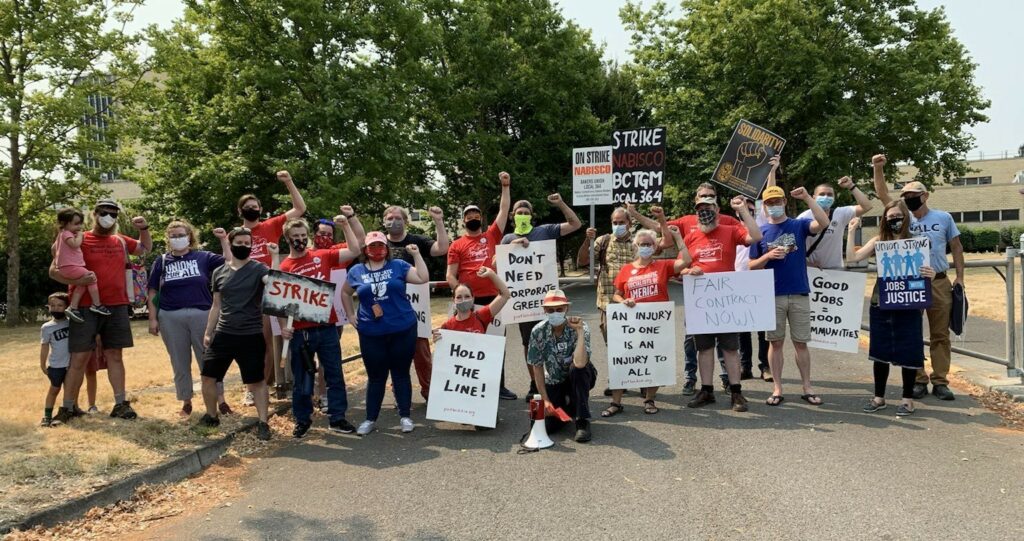Striketober Solidarity
Over the 40-day strike against Nabisco this summer, DSA chapters from five cities — Portland, OR; Richmond, VA; Denver; Atlanta; and Chicago — collaborated in a national solidarity campaign with local actions that bolstered the army of union bakers. In Portland, it was game-changing — for both DSA and the bakers.
On August 10, 2021, 200 workers represented by Bakers, Confectioners, Tobacco and Grain Millers (BCTGM) Local 364 walked off the job at the Nabisco/Mondelez plant in Portland. Bakers at the five other Nabisco facilities around the country soon followed their lead, totalling about 1,000 workers on strike. They were fighting the threat of outsourcing and Mondelez’s attempts to cut their health care benefits, overtime pay, and schedules. On September 18, workers ratified a national agreement that preserved their benefits and implemented a new scheduling system — despite Portland bakers voting overwhelmingly to continue striking for a better deal.

During the strike, Portland DSA held five rallies attended by 100-200 people, raised almost $100,000 for their strike fund (and inspired other locals to start GoFundMe campaigns of their own), and ended up recruiting some of the strongest rank-and-file bakers to DSA. We unified experienced longstanding DSA members across caucuses, educated members on strikes and community solidarity, and mobilized dozens of new members. Strike supporters even succeeded in interfering with production by deterring supply deliveries and blocking replacement labor.
Strike leaders from BCTGM Local 364 repeatedly said that the involvement of DSA was critical to the strike and was the catalyst for a militant awakening among many Nabisco workers. Having seen the impact we had, other unions in the Portland area — like OFNHP representing Kaiser healthcare workers — are now looking to DSA for organizational solidarity as they consider going on strike. Building a strong reputation for DSA in the labor movement gets us closer to collapsing the gap between the socialist movement and the rest of the working class.
Through our efforts we discovered tactics and best practices to be used in future solidarity campaigns. Not all of the advice we can give will perfectly fit every situation. In the case of BCTGM Local 364 in Portland, local leadership welcomed our involvement and were willing to wage a serious fight against the employer. Otherwise, a solidarity campaign would have been extremely difficult. But for other DSA chapters looking to replicate what we achieved, this is what we learned.
1. Come often, bring energy, make relationships
This is without a doubt the most important thing you can do, and it is what will allow you to effectively carry out all the other actions described in this article: Go to the picket line. Go to the picket line. Go to the picket line.
Bring food and drink (maybe fruit, not just donuts!). Introduce yourself to the picket captain or crew and follow their directions. Talk to lots of strikers and say you are a member of DSA. Take note of elected union leaders like shop stewards as well as informal leaders that workers respect. Ask people’s names and remember them. Ask them why they went on strike, what it’s like to work there, how long they’ve been there, how they’re feeling about the strike, and what the union members need. Listen and remember what specifically they are fighting for. Empathize and sympathize, even if you hear sentiments you have mixed feelings about.
If you are a union member, say that and mention an ongoing struggle in your workplace. Tell them why their strike is important to you and why DSA wants to support them. Remind them that most workers have never been on strike. Praise them for taking this bold step and making the sacrifice to show the rest of us how to fight back against the corporations and the billionaires.
Speak from the heart. Show them you are happy to be there. Cheer at honking cars, dance to the music, wave signs with spirit. Share good news and scuttlebutt. Tell workers you’ll be back again, and then come back again.
When you come back, remind people that you’ve spoken before. Repeat every time: “My name is X, I’m with DSA, and I’m a member of (union).” Tell them you hope they will come out to support you when you go on strike – establishing that solidarity is a two-way street, not charity.
When you have established a rapport, ask people for their social media handles or phone numbers to connect with them after the action. Follow up: chat about the strike and send them pictures you took. Invite them to a DSA meeting to share their experience being on strike.

2. Organize support actions
Solidarity actions from the community — like rallies or protests — can serve several basic goals: give workers a morale boost, connect DSA with the labor movement, and object to continued company operations. Whatever activities you engage in, communicate consistently with the strikers about their needs and how you can be most helpful. Don’t be afraid to make suggestions, as union members may not have much pre-existing idea of what community support could look like.
Community Rallies
Once you have established a relationship with people on the line, ask if there will be any rallies for community support. If yes, mobilize DSA members and allied union members to the rally. Ask who is planning it and how to get in touch with them to help out (it might be Jobs with Justice or a regional union council). Ask to have a DSA speaker.
If no community solidarity event has been planned, offer to organize one. Communicate closely and directly with the contacts you’ve made on the line. Ask them when would be a good time and place to hold the rally. Ask them which of their union members should speak at the rally, or directly invite your contacts to speak. Invite other union rank-and-filers to speak on behalf of their local.
For increased media attention, invite elected officials to speak, even ones you would never consider endorsing as DSA. Get a charismatic MC. Have one speaker who represents DSA and talks about why socialists believe strikes are important.
Do as much turnout as possible to the rally: email and text your DSA chapter, and spread the word to allied groups like Jobs with Justice, Sunrise Movement, Our Revolution, Coalition of Black Trade Unionists, AFL-CIO, and other unions and labor councils. Big turnout makes a big impact.
Make attractive digital flyers and signal boost the event on social media. Alert local media about the rally beforehand so they can be there and report on it. Bring signs supporting the strike, at least some of which should mention DSA (e.g. “DSA ❤ BCTGM” or a generic slogan with the name of your chapter in small print at the bottom). Wear DSA shirts and union swag. Take pictures of the crowd and video of the speakers, share it on social media, and send it to your contacts.
Picket Line Shifts
Mobilize people to walk the picket line during a given time frame, maybe around two to four hours. This can be especially helpful if union members tell you there’s a particular time of day or a particular location where they need bodies on the line. Treat it like a rally without the central focus of speakers. Bring supplies, megaphones, and signs. Wear DSA shirts and union swag. If you have multiple shifts or multiple locations to fill, assign DSA “picket captains” who are responsible for coordinating the supporters at their shift. Encourage unions and other community groups (such as faith, sports, or music groups) to take picket line shifts — especially those with DSA members who can carry the message.
Consider flyering or even door-knocking the neighborhoods around the picket lines to invite neighbors to come to the line or display a window sign supporting the strike. Ask local businesses to also display signs or donate food and supplies to the strikers.
Direct Actions and Disruptions
Consider ways to pose an objection to company operations during the strike — by directly protesting strike-breaking labor (scabs), supply delivery, or other interactions that are essential to production. You may even be able to achieve this without a protest: alert other unions who interact with the employer — such as Teamster delivery drivers or union railroad workers — and ask them to refuse, delay, or worsen service to the employer for the duration of the strike.
Whenever possible, make your action visible to the strikers, as witnessing the bravery of strangers on their behalf can give workers an enormous morale boost. If workers can’t be there to see your action, then film it and show it to them later.
DSA visibility can also protect strikers from legal action; community members exercising their First Amendment rights are less restricted than union members trying to abide by oppressive labor laws. Keep this in mind when publicizing events: bosses are more than willing to get aggressive in filing lawsuits to try to impede strikes and solidarity work, so don’t give them easy ammunition by implying any action beyond individuals engaging in free speech protests.
Get creative with your tactics. Here are some ideas:
- Protest scabs and delivery workers as they enter and exit the facility, such as with a large group of people who stand in front of entrances and exits or by parking cars or creating other barriers. Yell and chant until they go away or at least make it more difficult and uncomfortable for them to continue as normal. Police response to such actions will vary greatly city to city, but in some places it may take them a long time to respond, and even longer for a tow truck to finally arrive. If you use parked cars, mitigate the risk of getting towed by being ready to drive away as soon as the truck arrives. Peaceful blocking with bodies can be easily combined with rallies or picket line support as described above.
- If the employer has brought in scabs from out of town, research where they are staying and stage an action at their hotel. Figure out what their work schedule is; you may need to do some reconnaissance at the hotel or work site. Show up at the hotel in the middle of their sleep schedule and wake them up with loud noises like chanting, pots and pans, or car horns. Only a few minutes of noise-making is needed to make this effective. Or, at the start or end of their shift, stage an action in the entrance of the hotel or hotel parking lot. Create a “walk of shame” by forcing strike-breakers to pass through a crowd of hostile (but nonviolent) protesters.
- Sometimes the main object of a strike is to create a public crisis that poisons the company brand or compels political decision-makers to act. To accomplish this, all kinds of creative, disruptive, attention-grabbing actions can work: marches, car or bicycle caravans, street blockades, sit-ins, loud and visual disruptions of services inside or outside the worksite, dramatic props like giant puppets or postcards, mock ceremonies, vigils, takeovers of meetings, town halls, calling into talk shows, letters to the editor, or occupying key locations for the employer, such as a school, company headquarters, a retail location, or even in front of a manager’s home. Use intel from workers to determine the best target.
Take care before each action to learn your legal rights (such as what part of the road is public property), make sure all involved know their legal rights and risks, and commit to a level of risk that you are comfortable with. Do not attempt risky actions alone; aim for a group of at least eight people.
Get group unity on what your plan is in the case that police arrive or security initiates a physical confrontation. Designate someone to take pictures and video during the action. Send photos and accounts of these actions to the local press.
Don’t expect to fully prevent production from a single action — even disruptions that merely make normal operations painful can be quite effective, and again, making an audacious show of solidarity with workers is important on its own. (And no solidarity action can disrupt production like a strike by the workers themselves does!) In order to build confidence among yourselves and the workers, escalate the intensity of actions gradually — but not too slowly because the strike may end before you get the chance to act.
Take it seriously if strikers are concerned about escalating actions too much, and don’t put your relationships with them in jeopardy. What union staffers tell you can be good to know, but keep in mind that they and higher elected leadership may take a more conservative approach than rank-and-file members. Avoid alienating powerful decision-makers and individuals that workers regard as a leader. If a conflict arises, prioritize honoring the wishes of the workers. That may mean either following instructions that disappoint you or risking a political conflict with staffers and leadership.

3. Use and build the organizational power of DSA
Strike solidarity campaigns are an opportunity to use the organization we have and to find new ways of growing it. Although the most important ways to engage with a strike are in sections 1 and 2 of this guide, ask yourselves these questions too.
- What does your chapter infrastructure need to make strike support possible? Do you have the supplies you would need to mobilize to a rally, and are your chapter members prepared to use them (e.g., megaphones, DSA banner, DSA shirts or pins, PA system)? For turnout, do you have an email listserv and can you submit a mass text request through Spoke? What social media platforms can you use?
- Who is a union member in your chapter? National DSA can provide you with a list! Can you contact each of them individually and ask them to get their local to support the strike?
- What nearby chapters can you mobilize for turnout in addition to your own? Are there chapters elsewhere in the country that could do a solidarity action, such as picketing a company headquarters?
- Does the local union need fundraising support? Can you boost their strike fund on social media or make a GoFundMe for them? Can you make and sell buttons or other items to then donate the proceeds? Can your chapter donate directly to their strike fund? Can you contact other chapters or local unions in the area and ask them to do the same?
- What forums can you use to educate DSA members and others about the workers’ struggle and the history of their union and industry? Can you invite strikers to speak at a political education event or give an update at a general meeting?
Ask Strikers to Join DSA
Class warriors need organization, and the socialist movement needs class warriors. There are practically no better recruits for DSA than working people who have firsthand experience organizing their coworkers and seeing what it takes to stand up to employers and the ruling class.
Strike solidarity campaigns allow us to make relationships with people outside the typical DSA orbit, and we can follow through and get them to become members. Think about who you met on the picket line that has leadership skills and a fighting spirit. Be respectful, be enthusiastic, and invite them to join us in building a strong labor movement and working class power for the long term. To avoid any off-putting feelings, wait to ask workers to join once you’ve built relationships and shown them the kind of work DSA does; then it’s only natural to encourage them to be part of that classwide solidarity work and our political project.
Laura Wadlin is the Secretary of AFT Local 2277 and co-chair of Portland DSA.
